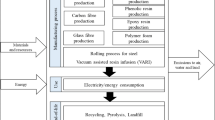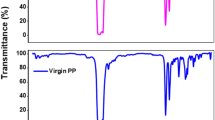Abstract
The use of renewable materials and cleaner production is currently the target of the automotive industry to reduce the use-phase environmental impacts of vehicles. Renewable lightweight materials are used to replace conventional materials to produce lightweight automotive parts, leading to reduced fuel consumption, which contributes toward meeting the industry’s environmental impact target. In this study, we compared the life cycle of a conventional composite to that of a biocomposite for automotive applications using the standard set by the International Standards Organization (ISO 2006). The conventional one is talc-reinforced polypropylene composite (talc–PP) at a 70% PP to 30% talc weight ratio. The biocomposite is Miscanthus biochar-reinforced polypropylene composite (MB–PP) at a 70% PP to 30% MB. The functional unit is 982 cm3 of composite used for a certain vehicle part (i.e., an automotive component). The environmental impacts are determined using the Tool for the Reduction and Assessment of Chemical and Other Environmental Impacts (TRACI, v2.1). The system boundary includes material extraction to the disposal stage of the composites. The results revealed that MB–PP composite had the least impact for all categories than talc–PP composite and appeared to be a favorable option for automotive parts from an environmental perspective. This study indicates that MB-PP can reduce about 25% environmental impacts of the life of composite if it replaces the talc–PP composite. The MB–PP composite emerged as a promising option than talc–PP composite and has environmentally benign green credentials for automotive parts application.
Graphic abstract







Similar content being viewed by others
References
Akhshik M, Panthapulakkal S, Tjong J, Sain M (2017) Life cycle assessment and cost analysis of hybrid fiber-reinforced engine beauty cover in comparison with glass fiber-reinforced counterpart. Environ Impact Assess Rev 65:111–117
Arrigoni A, Pelosato R, Melia P et al (2017) Life cycle assessment of natural building materials: the role of carbonation, mixture components and transport in the environmental impacts of hempcrete blocks. J Clean Prod 149:1051–1061
Badino V, Baldo GL, Fornaro M, Salvaia E (1995) Ecobalance of talc mineral production. III International Congress “Energy Evironmenta and Technological Innovation”, II. 125–131
Bare J (2011) TRACI 2.o: the tool for the reduction and assessment of chemical and other environmental impacts 2.o. Clean Technol Environ Policy 13:687–696. https://doi.org/10.1007/s10098-010-0338-9
Barth M, Carus M (2015) Carbon footprint and sustainability of different natural fibres for biocomposites and insulation material. Hürth Nova-Institute Available online http//eiha org/media/2017/01/15-04-Carbon-Footprint-of-Natural-Fibres-nova1 pdf. Accessed 5 Sept 2017
Bartocci P, Bidini G, Saputo P, Fantozzi F (2016) Biochar pellet carbon footprint. Chem Eng 50:217–222
Behazin E, Misra M, Mohanty AK (2017) Sustainable biocarbon from pyrolyzed perennial grasses and their effects on impact modified polypropylene biocomposites. Compos Part B Eng 118:116–124. https://doi.org/10.1016/j.compositesb.2017.03.003
Beigbeder J, Soccalingame L, Perrin D et al (2019) How to manage biocomposites wastes end of life? A life cycle assessment approach (LCA) focused on polypropylene (PP)/wood flour and polylactic acid (PLA)/flax fibres biocomposites. Waste Manag 83:184–193
Boland C, Dekleine R, Moorthy A et al (2014) A life cycle assessment of natural fiber reinforced composites in automotive applications. SAE Tech Pap. https://doi.org/10.4271/2014-01-1959
Boland CS, De Kleine R, Keoleian GA et al (2016) Life cycle impacts of natural fiber composites for automotive applications: effects of renewable energy content and lightweighting. J Ind Ecol 20:179–189. https://doi.org/10.1111/jiec.12286
Brassard P, Godbout S, Pelletier F et al (2018) Pyrolysis of switchgrass in an auger reactor for biochar production: a greenhouse gas and energy impacts assessment. Biomass Bioenerg 116:99–105
Civancik-Uslu D, Ferrer L, Puig R, Fullana-i-Palmer P (2018) Are functional fillers improving environmental behavior of plastics? A review on LCA studies. Sci Total Environ 626:927–940. https://doi.org/10.1016/j.scitotenv.2018.01.149
Corbière-Nicollier T, Gfeller Laban B, Lundquist L et al (2001) Life cycle assessment of biofibres replacing glass fibres as reinforcement in plastics. Resour Conserv Recycl 33:267–287. https://doi.org/10.1016/S0921-3449(01)00089-1
Delogu M, Zanchi L, Dattilo CA, Pierini M (2017) Innovative composites and hybrid materials for electric vehicles lightweight design in a sustainability perspective. Mater Today Commun 13:192–209. https://doi.org/10.1016/j.mtcomm.2017.09.012
Delogu M, Zanchi L, Maltese S et al (2016) Environmental and economic life cycle assessment of a lightweight solution for an automotive component: a comparison between talc-filled and hollow glass microspheres-reinforced polymer composites. J Clean Prod 139:548–560. https://doi.org/10.1016/j.jclepro.2016.08.079
Europe P (2005) Eco-profiles of the European plastics industry. Low Density Polyethylene, pp 1–19
Fogorasi M, Barbu I (2017) The potential of natural fibres for automotive sector: review. IOP Conf Ser Mater Sci Eng 252:012044. https://doi.org/10.1088/1757-899X/252/1/012044
Giroux L, Consulting GE (2014) State of waste management in Canada. Canadian Council of Ministers of the Environment
Government of Canadan (2018) Environment and Climate Change Canada (2018) Canadian environmental sustainability indicators: greenhouse gas emissions
Greenblatt JB, Shaheen S (2015) Automated vehicles, on-demand mobility, and environmental impacts. Curr Sustain Energy Rep 2:74–81
Guinée JB, Heijungs R, Huppes G (2004) Economic allocation: examples and derived decision tree. Int J Life Cycle Assess 9:23
Han J, Elgowainy A, Dunn JB, Wang MQ (2013) Life cycle analysis of fuel production from fast pyrolysis of biomass. Bioresour Technol 133:421–428
Han J, Elgowainy A, Palou-Rivera I, et al (2011) Well-to-wheels analysis of fast pyrolysis pathways with the GREET model. Argonne National Lab.(ANL), Argonne, IL (United States)
Hervy M, Evangelisti S, Lettieri P, Lee K-Y (2015) Life cycle assessment of nanocellulose-reinforced advanced fibre composites. Compos Sci Technol 118:154–162. https://doi.org/10.1016/J.COMPSCITECH.2015.08.024
ISO (2006) Environmental management—Life cycle assessment—Requirements and guidelines
Jahirul MI, Rasul MG, Chowdhury AA, Ashwath N (2012) Biofuels production through biomass pyrolysis—a technological review. Energies 5:4952–5001. https://doi.org/10.3390/en5124952
Jan MR, Shah J, Gulab H (2013) Catalytic conversion of waste high-density polyethylene into useful hydrocarbons. Fuel 105:595–602. https://doi.org/10.1016/j.fuel.2012.09.016
Jungbluth N, Bauer C, Dones R, Frischknecht R (2005) Life cycle assessment for emerging technologies: case studies for photovoltaic and wind power (11 pp). Int J Life Cycle Assess 10:24–34
Kim HC, Wallington TJ (2013) Life-cycle energy and greenhouse gas emission benefits of lightweighting in automobiles: review and harmonization. Environ Sci Technol 47:6089–6097. https://doi.org/10.1021/es3042115
Kong S (2011) (12) United States Patent 2, pp 12–15
Leme MMV, Rocha MH, Lora EES et al (2014) Techno-economic analysis and environmental impact assessment of energy recovery from Municipal Solid Waste (MSW) in Brazil. Resour Conserv Recycl 87:8–20
Luz SM, Caldeira-Pires A, Ferrão PMC (2010) Environmental benefits of substituting talc by sugarcane bagasse fibers as reinforcement in polypropylene composites: ecodesign and LCA as strategy for automotive components. Resour Conserv Recycl 54:1135–1144. https://doi.org/10.1016/j.resconrec.2010.03.009
Mashouf Roudsari G, Mohanty AK, Misra M (2017) A statistical approach to develop biocomposites from epoxy resin, poly(furfuryl alcohol), poly(propylene carbonate), and biochar. J Appl Polym Sci 134:1–11. https://doi.org/10.1002/app.45307
Molins G, Álvarez MD, Garrido N et al (2018) Environmental impact assessment of polylactide (PLA)/chicken feathers biocomposite materials. J Polym Environ 26:873–884
Moussa H (2014) Life cycle assessment of a hybrid poly butylene succinate composite
Narayan R (2011) Carbon footprint of bioplastics using biocarbon content analysis and life-cycle assessment. MRS Bull 36:716–721. https://doi.org/10.1557/mrs.2011.210
Neufeld R, Massicotte PJ (2017) Decarbonizing transportation in Canada
Peters JF, Iribarren D, Dufour J (2015) Simulation and life cycle assessment of biofuel production via fast pyrolysis and hydroupgrading. Fuel 139:441–456
Poulikidou S, Schneider C, Björklund A et al (2015) A material selection approach to evaluate material substitution for minimizing the life cycle environmental impact of vehicles. Mater Des 83:704–712. https://doi.org/10.1016/j.matdes.2015.06.079
Roy P, Nei D, Okadome H et al (2008) Life cycle inventory analysis of fresh tomato distribution systems in Japan considering the quality aspect. J Food Eng 86:225–233. https://doi.org/10.1016/j.jfoodeng.2007.09.033
Roy P, Tadele D, Defersha F et al (2019) Environmental and economic prospects of biomaterials in the automotive industry. Clean Technol Environ Policy 21(8):1535–1548
Snowdon MR, Mohanty AK, Misra M (2017) Miscibility and Performance Evaluation of Biocomposites Made from Polypropylene/Poly(lactic acid)/Poly(hydroxybutyrate-cohydroxyvalerate) with a Sustainable Biocarbon Filler. ACS Omega 2:6446–6454. https://doi.org/10.1021/acsomega.7b00983
Subic A, Schiavone F, Leary M, Manning J (2010) Comparative Life Cycle Assessment (LCA) of passenger seats and their impact on different vehicle models. Int J Veh Des 53:89–109
Tadele D, Roy P, Defersha F et al (2019) Life Cycle Assessment of renewable filler material (biochar) produced from perennial grass (Miscanthus). AIMS Energy 7:430–440. https://doi.org/10.3934/energy.2019.4.430
Vidal R, Martínez P, Garraín D (2009) Life cycle assessment of composite materials made of recycled thermoplastics combined with rice husks and cotton linters. Int J Life Cycle Assess 14:73–82. https://doi.org/10.1007/s11367-008-0043-7
Väisänen T, Das O, Tomppo L (2017) A review on new bio-based constituents for natural fiber-polymer composites. J Clean Prod 149:582–596. https://doi.org/10.1016/j.jclepro.2017.02.132
Wang T, Rodriguez-Uribe A, Misra M, Mohanty AK (2018) Sustainable carbonaceous biofiller from miscanthus: size reduction, characterization, and potential bio-composites applications. BioResources 13:3720–3739. https://doi.org/10.15376/biores.13.2.3720-3739
Wang H, Wang L, Shahbazi A (2015) Life cycle assessment of fast pyrolysis of municipal solid waste in North Carolina of USA. J Clean Prod 87:511–519
Witik RA, Payet J, Michaud V et al (2011) Assessing the life cycle costs and environmental performance of lightweight materials in automobile applications. Compos Part A Appl Sci Manuf 42:1694–1709. https://doi.org/10.1016/j.compositesa.2011.07.024
Wright MM, Daugaard DE, Satrio JA, Brown RC (2010) Techno-economic analysis of biomass fast pyrolysis to transportation fuels. Fuel 89:S2–S10
Acknowledgements
The authors would like to acknowledge financial support from the Ontario Research Fund–Research Excellence (ORF-RE) round-7 award and the growth fund from the School of Engineering, University of Guelph.
Author information
Authors and Affiliations
Corresponding authors
Additional information
Publisher's Note
Springer Nature remains neutral with regard to jurisdictional claims in published maps and institutional affiliations.
Electronic supplementary material
Below is the link to the electronic supplementary material.
Rights and permissions
About this article
Cite this article
Tadele, D., Roy, P., Defersha, F. et al. A comparative life-cycle assessment of talc- and biochar-reinforced composites for lightweight automotive parts. Clean Techn Environ Policy 22, 639–649 (2020). https://doi.org/10.1007/s10098-019-01807-9
Received:
Accepted:
Published:
Issue Date:
DOI: https://doi.org/10.1007/s10098-019-01807-9




